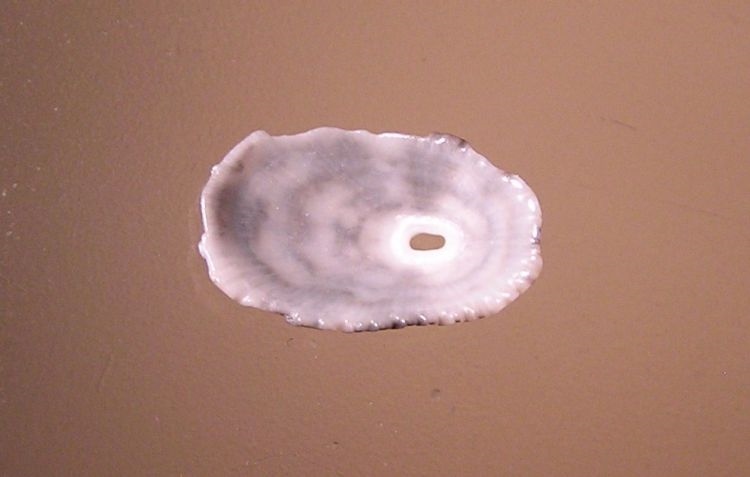Diodora Ruepellii on:
[Wikipedia]
[Google]
[Amazon]
 ''Diodora rueppellii'',
''Diodora rueppellii'',
Odhner, N.H.J. (1919). Contribution a la faune malacologique de Madagascar. Arkiv för Zoologi, K. Svenska Vetenskapsakademien, 12(6): 1–52, 4 pl
Fissurellidae Gastropods described in 1835 {{Fissurellidae-stub
 ''Diodora rueppellii'',
''Diodora rueppellii'', common name
In biology, a common name of a taxon or organism (also known as a vernacular name, English name, colloquial name, country name, popular name, or farmer's name) is a name that is based on the normal language of everyday life; and is often contrast ...
the Rüppell's keyhole limpet, is a species
In biology, a species is the basic unit of classification and a taxonomic rank of an organism, as well as a unit of biodiversity. A species is often defined as the largest group of organisms in which any two individuals of the appropriate s ...
of sea snail
Sea snail is a common name for slow-moving marine gastropod molluscs, usually with visible external shells, such as whelk or abalone. They share the taxonomic class Gastropoda with slugs, which are distinguished from snails primarily by the ...
, a marine gastropod
The gastropods (), commonly known as snails and slugs, belong to a large taxonomic class of invertebrates within the phylum Mollusca called Gastropoda ().
This class comprises snails and slugs from saltwater, from freshwater, and from land. T ...
mollusc
Mollusca is the second-largest phylum of invertebrate animals after the Arthropoda, the members of which are known as molluscs or mollusks (). Around 85,000 extant species of molluscs are recognized. The number of fossil species is esti ...
in the family
Family (from la, familia) is a Social group, group of people related either by consanguinity (by recognized birth) or Affinity (law), affinity (by marriage or other relationship). The purpose of the family is to maintain the well-being of its ...
Fissurellidae
Fissurellidae, common name the keyhole limpets and slit limpets, is a taxonomic family of limpet-like sea snails, marine gastropod molluscs in the clade Vetigastropoda.Rosenberg, G. (2012). Fissurellidae. Accessed through: World Register of Marin ...
, the keyhole limpets.
Description
''Diodora ruppellii'' has a shell with a whitish exterior marked with a radial pattern of dark blotches and a white interior surface marked with a faint pattern similar to the exterior. The shell is asteeply conical, elongated oval with a hole at the apex, which is roughly a third of the length of the shell from its anterior end. There are 20 to 25 radiating ribs on the exterior surface of the shell with some smaller ribs between them; the growth ridges are not as developed as the ribs and form knobs at where they intersect. The edges of the apical hole have conspicuous crenulations where they meet the ribs, the notches between the crenulations continue a short distance towards the inside of the shell. The shell can be up to 20 mm long, although 15mm is the most common length, and 10 mm high, in Red Sea specimens.Distribution
''Diodora ruppellii'' has anIndo-Pacific
The Indo-Pacific is a vast biogeographic region of Earth.
In a narrow sense, sometimes known as the Indo-West Pacific or Indo-Pacific Asia, it comprises the tropical waters of the Indian Ocean, the western and central Pacific Ocean, and the ...
distribution occurring in the Red Sea and along the east African coasts as far south as KwaZulu-Natal
KwaZulu-Natal (, also referred to as KZN and known as "the garden province") is a province of South Africa that was created in 1994 when the Zulu bantustan of KwaZulu ("Place of the Zulu" in Zulu) and Natal Province were merged. It is locate ...
and east through the Indian Ocean and Pacific Ocean to Hawaii
Hawaii ( ; haw, Hawaii or ) is a state in the Western United States, located in the Pacific Ocean about from the U.S. mainland. It is the only U.S. state outside North America, the only state that is an archipelago, and the only stat ...
. It was recorded in the Suez Canal in 1905 and reaching the Mediterranean in 1948 when it was recorded off the coast of Israel and had spread to south-eastern Turkey by 1995.
Ecology
Species in the genus '' Diodora'' feed on sponges from the undersides of rocks and boulders. ''Diodora ruppellii'' is normally found in the intertidal zone on rocky shores but has been dredged up from gravel substrates.References
* Dautzenberg, Ph. (1923). ''Liste préliminaire des mollusques marins de Madagascar et description de deux espèces nouvelles''. J. conchyliol. 68: 21–74 * Dautzenberg, Ph. (1929). ''Contribution à l'étude de la faune de Madagascar: Mollusca marina testacea. Faune des colonies françaises, III(fasc. 4).'' Société d'Editions géographiques, maritimes et coloniales: Paris. 321–636, plates IV-VII pp. * Abbott, R.T. & S.P. Dance (1986). ''Compendium of sea shells''. American Malacologists, Inc:Melbourne, Florida * Gofas, S.; Le Renard, J.; Bouchet, P. (2001). Mollusca, in: Costello, M.J. et al. (Ed.) (2001). ''European register of marine species: a check-list of the marine species in Europe and a bibliography of guides to their identification''. Collection Patrimoines Naturels, 50: pp. 180–213 * Streftaris, N.; Zenetos, A.; Papathanassiou, E. (2005). ''Globalisation in marine ecosystems: the story of non-indigenous marine species across European seas.'' Oceanogr. Mar. Biol. Annu. Rev. 43: 419–453 * Severns M. (2011) ''Shells of the Hawaiian Islands – The Sea Shells''. Conchbooks, Hackenheim. 564 pp. page(s): 36External links
Odhner, N.H.J. (1919). Contribution a la faune malacologique de Madagascar. Arkiv för Zoologi, K. Svenska Vetenskapsakademien, 12(6): 1–52, 4 pl
Fissurellidae Gastropods described in 1835 {{Fissurellidae-stub